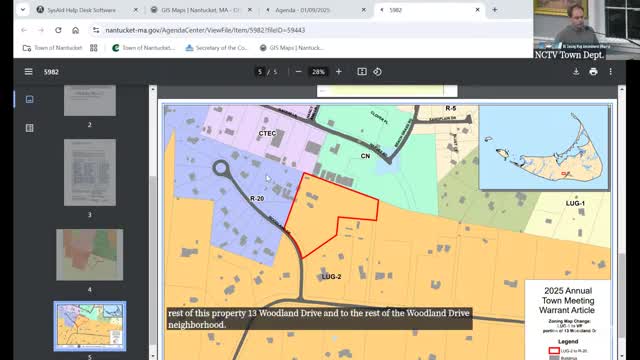Nantucket developers propose affordable housing plan amid community concerns over density and traffic
December 26, 2024 | Nantucket County, Massachusetts
This article was created by AI summarizing key points discussed. AI makes mistakes, so for full details and context, please refer to the video of the full meeting. Please report any errors so we can fix them. Report an error »

In a special meeting of the Nantucket Planning Board held on January 9, 2025, community members and board members engaged in a spirited discussion about a proposed housing development that could significantly alter the landscape of the area. The proposal, which aims to increase the number of buildable lots from five to twelve, has sparked concerns among residents about the potential impact on traffic, neighborhood character, and the overall approach to affordable housing on the island.
At the heart of the discussion was a proposal to add a portion of the property to the sewer district, which would allow for the construction of year-round, affordable homes for individuals earning up to 240% of the Area Median Income (AMI). Proponents of the plan emphasized that these homes would be subject to voluntary restrictions, a point highlighted by one developer who noted that the initiative was not coerced but rather a proactive measure to address community housing needs.
However, residents voiced strong opposition, arguing that the projected increase in traffic—estimated at 30 additional cars during peak hours—would overwhelm local roads that lack sidewalks and public transportation options. One resident, Mary Lepre, expressed her concerns about the density of the proposed development, suggesting that building five covenant homes would better serve the community than the proposed twelve to twenty units. She emphasized the importance of maintaining the neighborhood's character and the need for thoughtful planning that respects existing zoning laws.
The meeting also featured voices from those in favor of the development, including Megan Boyce, who shared her personal experience of struggling to find affordable housing on the island. She highlighted the urgency of creating more housing options for young families and individuals who are being priced out of the market.
As the discussion unfolded, board members acknowledged the complexities of the issue, recognizing the pressing need for affordable housing while also considering the concerns of existing residents. The dialogue underscored a broader challenge facing Nantucket: balancing development with community needs and maintaining the island's unique character.
In conclusion, the meeting revealed a community at a crossroads, grappling with the implications of new housing developments. As Nantucket continues to confront its housing crisis, the outcomes of these discussions will play a crucial role in shaping the future of the island and its residents. The planning board's next steps will be closely watched as they navigate the delicate balance between growth and preservation.
At the heart of the discussion was a proposal to add a portion of the property to the sewer district, which would allow for the construction of year-round, affordable homes for individuals earning up to 240% of the Area Median Income (AMI). Proponents of the plan emphasized that these homes would be subject to voluntary restrictions, a point highlighted by one developer who noted that the initiative was not coerced but rather a proactive measure to address community housing needs.
However, residents voiced strong opposition, arguing that the projected increase in traffic—estimated at 30 additional cars during peak hours—would overwhelm local roads that lack sidewalks and public transportation options. One resident, Mary Lepre, expressed her concerns about the density of the proposed development, suggesting that building five covenant homes would better serve the community than the proposed twelve to twenty units. She emphasized the importance of maintaining the neighborhood's character and the need for thoughtful planning that respects existing zoning laws.
The meeting also featured voices from those in favor of the development, including Megan Boyce, who shared her personal experience of struggling to find affordable housing on the island. She highlighted the urgency of creating more housing options for young families and individuals who are being priced out of the market.
As the discussion unfolded, board members acknowledged the complexities of the issue, recognizing the pressing need for affordable housing while also considering the concerns of existing residents. The dialogue underscored a broader challenge facing Nantucket: balancing development with community needs and maintaining the island's unique character.
In conclusion, the meeting revealed a community at a crossroads, grappling with the implications of new housing developments. As Nantucket continues to confront its housing crisis, the outcomes of these discussions will play a crucial role in shaping the future of the island and its residents. The planning board's next steps will be closely watched as they navigate the delicate balance between growth and preservation.
View full meeting
This article is based on a recent meeting—watch the full video and explore the complete transcript for deeper insights into the discussion.
View full meeting
